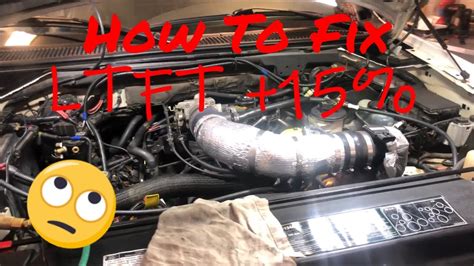How To Fix High Long Term Fuel Trim
Ronan Farrow
Mar 24, 2025 · 3 min read

Table of Contents
How to Fix High Long-Term Fuel Trim
A high long-term fuel trim (LTFT) indicates your car's engine control module (ECM) is constantly adding extra fuel to maintain the correct air-fuel ratio. This isn't just a minor inconvenience; it can lead to decreased fuel economy, rough idling, misfires, and even damage to your catalytic converter. Let's dive into the causes and solutions for this common problem.
Understanding Long-Term Fuel Trim
Before we jump into fixes, let's quickly understand what LTFT represents. Your car's ECM uses sensors (like the mass airflow sensor (MAF) and oxygen sensors (O2)) to monitor the air-fuel mixture entering the combustion chamber. The short-term fuel trim (STFT) adjusts for minor, immediate variations. The long-term fuel trim, however, reflects consistent adjustments needed over time to compensate for persistent issues. A high LTFT (typically above +10%) suggests a problem that needs attention.
Common Causes of High Long-Term Fuel Trim
Several factors can contribute to a consistently high LTFT. Let's examine the most frequent culprits:
1. Vacuum Leaks
A vacuum leak allows unmetered air to enter the engine, throwing off the air-fuel mixture. The ECM compensates by adding more fuel, resulting in a high LTFT. Identifying vacuum leaks often requires visual inspection of all vacuum hoses and connections. Look for cracks, loose clamps, or damaged hoses. Pay close attention to the intake manifold and PCV system.
2. Faulty Mass Airflow Sensor (MAF)
The MAF sensor measures the amount of air entering the engine. A malfunctioning MAF sensor can provide inaccurate readings, leading the ECM to inject the wrong amount of fuel. A dirty or faulty MAF sensor is a common cause of high LTFT. Cleaning the MAF sensor (carefully!) with MAF sensor cleaner is a good first step. If cleaning doesn't resolve the issue, replacement might be necessary.
3. Failing Oxygen Sensors (O2 Sensors)
Oxygen sensors monitor the exhaust gases to determine the air-fuel ratio. A faulty O2 sensor can provide inaccurate feedback to the ECM, leading to incorrect fuel delivery. Since there are usually multiple O2 sensors (upstream and downstream of the catalytic converter), testing each one individually is crucial. This often requires a specialized OBD-II scanner.
4. Dirty Fuel Injectors
Clogged or dirty fuel injectors can prevent the proper delivery of fuel, forcing the ECM to compensate with a higher fuel trim. Cleaning the fuel injectors can be achieved through various methods, including using fuel injector cleaner additive in the gas tank or professional cleaning.
5. Problems with the Fuel Pressure Regulator
This component regulates the fuel pressure within the fuel rail. A malfunctioning fuel pressure regulator can lead to inconsistent fuel delivery, resulting in a high LTFT. Diagnosing a faulty fuel pressure regulator usually requires testing the fuel pressure using a gauge.
6. Intake Air Leaks After the MAF Sensor
Leaks after the MAF sensor can also disrupt the air-fuel mixture. This is less common than vacuum leaks before the MAF, but it's still a possibility. Thorough inspection of all connections and seals in the intake system is needed.
Troubleshooting Steps
- Check for trouble codes: Use an OBD-II scanner to read any diagnostic trouble codes (DTCs). These codes can pinpoint potential issues.
- Visual Inspection: Carefully inspect all vacuum hoses, connections, and the intake system for leaks or damage.
- Clean the MAF Sensor: Gently clean the MAF sensor with MAF sensor cleaner.
- Check fuel pressure: If other steps don't solve the problem, check the fuel pressure to rule out a faulty fuel pressure regulator.
- Professional Diagnosis: If you're unable to identify the problem, it's best to seek professional help from a qualified mechanic.
Remember, a high long-term fuel trim is a serious issue that shouldn't be ignored. Addressing the underlying problem promptly will help prevent further damage and ensure your vehicle's optimal performance and fuel efficiency. Always consult your vehicle's repair manual for specific instructions and safety precautions.
Featured Posts
Also read the following articles
| Article Title | Date |
|---|---|
| How To Get Catalpa Worms On Trees Fast | Mar 24, 2025 |
| How To Get A Level 3 Security License In Texas | Mar 24, 2025 |
| How To Find Studs In Stucco | Mar 24, 2025 |
| How To Date Old 7up Bottles | Mar 24, 2025 |
| How To Fix Dura Touch Coating | Mar 24, 2025 |
Latest Posts
-
How Long After A Dog Bite Can You Sue
Apr 05, 2025
-
How Long After A Dental Implant Can I Drink Alcohol
Apr 05, 2025
-
How Long After A Cortisone Shot Can I Take Aleve
Apr 05, 2025
-
How Long After A Chiropractic Adjustment Can I Workout
Apr 05, 2025
-
How Long After A Cartilage Piercing Can You Swim
Apr 05, 2025
Thank you for visiting our website which covers about How To Fix High Long Term Fuel Trim . We hope the information provided has been useful to you. Feel free to contact us if you have any questions or need further assistance. See you next time and don't miss to bookmark.
